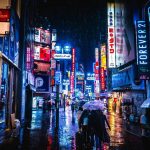Can Tucson, Arizona Bring Back its Miracle Mile?
In cities, certain neighborhoods may have a history that gave them an economic purpose, a distinctive aesthetic identity, and unique role in their city decades ago — even if time has moved on. When those neighborhoods fall on hard times, that identity can sour from a source of pride to one of perceived blight.
And while nostalgia may eventually return for what remains of the good old days, an obvious transition to a prosperous and sustainable future is harder to come by.
What roles should the history of the local built environment, economic development and social relationships play in influencing neighborhood revitalization? That question is at the heart of land use challenges in Tucson, Arizona, which is now receiving technical assistance from the Rose Center for Public Leadership’s land use fellowship.
For the city’s fellowship, Tucson Mayor Jonathan Rothschild aims to help the city guide infill development and neighborhood revitalization by studying the Oracle neighborhood, a 2.6 square mile district located north of downtown. Once the historic northern gateway into the city, the neighborhood now struggles with high poverty, low rates of homeownership, and property vacancies.
In the last decade, Tucson has seen unprecedented investment in infill development downtown. This is partly a result of its successful new streetcar line — which connects the University of Arizona area, 4th Avenue Business District, Mercado redevelopment area, and downtown — and partly due to reforms and tax breaks supporting transit-oriented development.
Having learned from this success, Tucson is now turning its community development priorities to lower-income neighborhoods that have not been able to attract private investment, like the Oracle area, whose Miracle Mile corridor was just listed on the National Register of Historic Places in December.
Between 1920 and 1960, any visitor traveling through Tucson experienced The Miracle Mile, the city’s 1.75-mile long automobile gateway north of downtown. With its Old Spanish Trail marketing, Tucson was one of the first cities to promote automobile-based tourism — dating all the way back in 1916!
As vehicle ownership skyrocketed in the 1920s, business catering to “auto-camping” tourists flourished along corridors leading to the city. Eventually, these grew to include “motor courts” with cabin lodging and some of the nation’s first motels.
By 1940, Tucson’s northern corridor had acquired the “Miracle Mile” nickname as a result of a road safety project: It was one of the first landscaped median roadways of the country. The highway’s booming motor courts and motels began competing for visitors with large, distinctive neon signs, drawing on influences from architecture, “Western” sensibilities, and nostalgic marketing trends. In the 1950s and 1960s, the signs incorporated contemporary trends like the Space Age and Neon Moderne.
When Interstate 10 was completed in 1961, the area began to decline — as tourists increasingly bypassed the Miracle Mile. Lacking traveling customers, motor courts turned to shadier clientele who paid hourly rates, and properties began to fall into disrepair as disinvestment set it.
The 17-story, 409-apartment luxury “Tucson House” — built in 1963 and once home to Congressman Mo Udall — went bankrupt 15 years later, was auctioned to U.S. HUD, and was converted into 100 subsidized apartments. Today, it provides much needed home to elderly and disabled tenants — but is again need of major renovation.
By 1987, the name “Miracle Mile” had become so associated with unsavory activity that the city renamed the main north-south stretch of the route Oracle Road. In just 50 years’ time, the brand had fallen from a draw to liability.
However, recent years have brought encouraging signs including the adaptive reuse of the long-vacant Ghost Ranch Lodge by Atlantic Development as affordable senior housing. Atlantic undertook a labor of love in restoring the property to its former grandeur — utilizing a complex capital stack including CDBG, HOME, LIHTC, and federal historic tax credits, among other sources. The results are a shining example of how to reuse historic properties — even if the funding complexity would be difficult to replicate en masse.
On Stone Avenue, a narrower street parallel to Oracle, new restaurants and housing are beginning to arrive. As land values continue to increase, tenants and users may come seeking lower cost sites — and Oracle has competitive advantages, due to its proximity to I-10, Downtown and the University of Arizona.
For the city of Tucson, the Rose Center’s expert panel offered recommendations focused on:
- Helping the City develop an intentional approach to equitable and inclusive community development through civic engagement in the process, data-based decision making, and tailoring the role of incentives and leveraging public funding
- Creating a comprehensive approach that includes all relevant city departments and agencies but championed by an economic development/neighborhood revitalization officer and an inclusion/community engagement officer (which can come from existing staff)
- Taking advantage of the presence of Pima Community College’s downtown campus in the area to make workforce development a catalyst for the neighborhood. This anchor institution is well connected to major regional employers and is growing its programs and real estate footprint. As that growth occurs it will create more demand for services in Oracle, as well opportunities to connect local residents to job training in those growth sectors of the regional economy. Their growth might also be the best opportunity to bring much needed healthy food retail and healthcare services to the neighborhood
- A neighborhood economic development strategy that focuses on supporting the area’s 500 local business to help them grow and hire locally
- Protecting local residents from the potential of displacement in the future by focusing on mixed-income redevelopment for the Tucson House and multi-family redevelopment as trailer parks transition from their current use. Also partnering with the Pascua Yaqui Tribe to acquire individual properties, as their communal ownership operates like a land trust model with a goal of maintaining affordable housing for their tribe members.
- Thinking about future users for underutilized industrial properties along I-10, particularly as real estate values increase Downtown
- Focusing on pedestrian safety due to the very low rates of car ownership, especially crossing the extremely wide arterial streets like Oracle, as well as enhancing the local bus infrastructure to give transit riders a better experience
- Playing on the historic auto theme by partnering with historic automobile enthusiast clubs to holding cruising nights along Oracle that fit in with its historic signs and architecture and can attract people to the area again for events to help change its image.
Over the coming year, the Rose Center and its faculty will be working to help Tucson implement these ideas before the fellowship formally ends at the City Summit in Los Angeles in November. Keep reading CitiesSpeak for updates and to learn about other cities’ land use challenges and opportunities.



